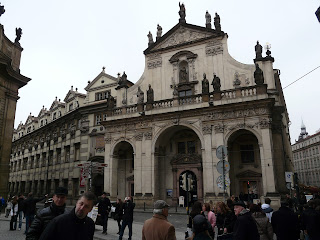While we were in the Czech Republic, we took a day trip to Kutna Hora. This city was once home to the world's largest silver mine. Silver was discovered in the area around 1260 AD. At the end of the 13th century, the mine provided about one third of European production of silver. At the turn of the 14th and 15th centuries, the mine attained a depth of 500 meters and was the deepest mine in the world at the time. Because of its wealth, Kutna Hora became the second most important city in the Kingdom of Bohemia, after Prague. The wealth of the local mines formed the basis of power for the Bohemian kings. The standard coinage for much of Europe was minted here. By about 1700, the mine played out and the city lost its source of revenue. Now Kutna Hora has a population of about 20,000.
Today, Kutna Hora is the home to biggest tobacco processor in the country and is Philip Morris' headquarters for Central Europe.
Kutna Hora has St. Barbara's Cathedral, the silver mine, and of course--the Sedlac Bone Church.
Today, Kutna Hora is the home to biggest tobacco processor in the country and is Philip Morris' headquarters for Central Europe.
Kutna Hora has St. Barbara's Cathedral, the silver mine, and of course--the Sedlac Bone Church.
Countryside between Prague and Kutna Hora
Countryside between Prague and Kutna Hora
Sedlac Bone Church: The Sedlac Monastery was founded near Kutna Hora in 1142. Inside this small church are the bones of 40,000 people. The bones were used to decorate the walls and ceilings. The 14th century plagues and the 15th century wars provided the raw material necessary for the creative monks who made the designs. Those who first placed these bones 400 years ago wanted viewers to remember that the earthly church is a community of both the living and the dead. Later bone-artists were more interested in design than theology.
Not your normal coat-of-arms but interesting.
Pyramid of Bones
Amazing how many bones were used to make this pyramid. Thousands of people died to provide the materials to build it. There are several of these pyramids in the church.
Ceiling decorations
Enlarge the picture to get a better understanding of what it took create it.
This bone chandelier contains every bone in the human body. Wouldn't you like to have this chandelier light up the entry way in your house?
Part of the bone pyramid
Skulls with obvious signs of mortal wounds. (Enlarge) Some were hit with battle axes, others with arrows, maces and some with clubs.
A lamp or goblet bordered by skull and crossbone art
Monument in Kutna Hora
The Italian Court
This palace, located on the site where Czech currency was once made, became Europe's most important mint and the main residence of Czech kings in the 1400's.
The statue in front is Tomas Masaryk. He was the George Washington of Czechoslovakia. Masaryk founded the first democracy in Eastern Europe at the end of WWI, uniting the Czechs and the Slovaks. Interesting trivia: Masaryk is one of only 3 foreign leaders to have a statue in Washington, DC. (The other 2 are Gandhi and Winston Churchill)
Kutna Hora
Kutna Hora
St. Barbara's Cathedral and the former Baroque Jesuit college
St. Barbara's Cathedral (St Barbara is the patron saint of miners which makes sense for Kutna Hora). It was founded in 1388.
Street leading to St. James Church. Notice that the bell tower on the right was never completed. The weight caused the foundation beneath the church to settle because the entire town is built over the silver mine below.
Street in Kutna Hora
Stone Fountain--Because of the mining under the town, Kutna Hora has always struggled with obtaining clean drinking water. Water was brought to town by a system of water pipes and then stored in large tanks. This 12-sided Gothic structure was built in the 15th century and put over one of the water storage tanks.

















































